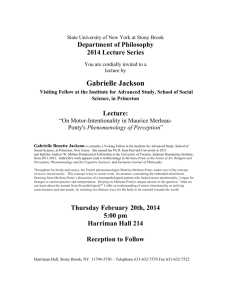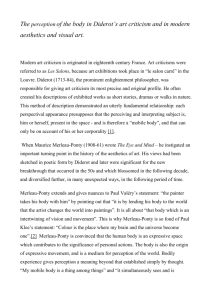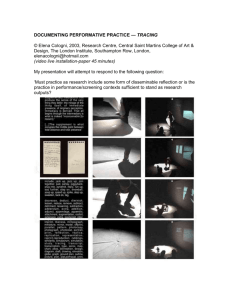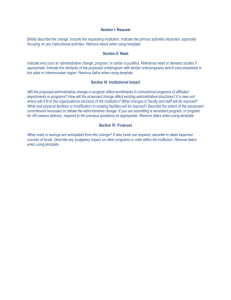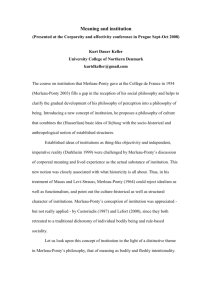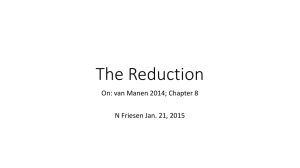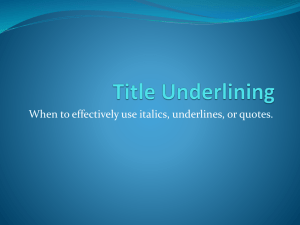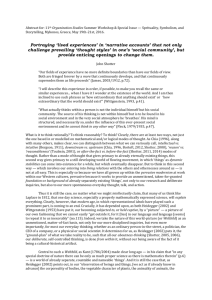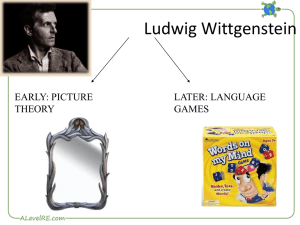The importance of how we word expressions
advertisement
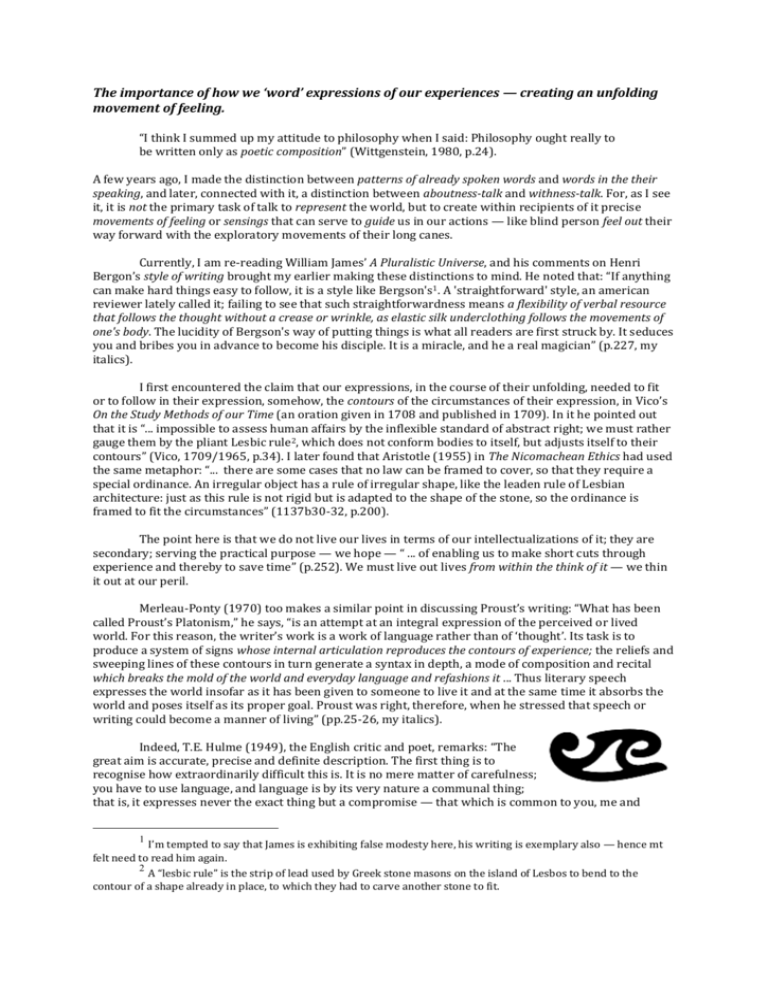
The importance of how we ‘word’ expressions of our experiences — creating an unfolding movement of feeling. “I think I summed up my attitude to philosophy when I said: Philosophy ought really to be written only as poetic composition” (Wittgenstein, 1980, p.24). A few years ago, I made the distinction between patterns of already spoken words and words in the their speaking, and later, connected with it, a distinction between aboutness-talk and withness-talk. For, as I see it, it is not the primary task of talk to represent the world, but to create within recipients of it precise movements of feeling or sensings that can serve to guide us in our actions — like blind person feel out their way forward with the exploratory movements of their long canes. Currently, I am re-reading William James’ A Pluralistic Universe, and his comments on Henri Bergon’s style of writing brought my earlier making these distinctions to mind. He noted that: “If anything can make hard things easy to follow, it is a style like Bergson's1. A 'straightforward' style, an american reviewer lately called it; failing to see that such straightforwardness means a flexibility of verbal resource that follows the thought without a crease or wrinkle, as elastic silk underclothing follows the movements of one's body. The lucidity of Bergson's way of putting things is what all readers are first struck by. It seduces you and bribes you in advance to become his disciple. It is a miracle, and he a real magician” (p.227, my italics). I first encountered the claim that our expressions, in the course of their unfolding, needed to fit or to follow in their expression, somehow, the contours of the circumstances of their expression, in Vico’s On the Study Methods of our Time (an oration given in 1708 and published in 1709). In it he pointed out that it is “... impossible to assess human affairs by the inflexible standard of abstract right; we must rather gauge them by the pliant Lesbic rule2, which does not conform bodies to itself, but adjusts itself to their contours” (Vico, 1709/1965, p.34). I later found that Aristotle (1955) in The Nicomachean Ethics had used the same metaphor: “... there are some cases that no law can be framed to cover, so that they require a special ordinance. An irregular object has a rule of irregular shape, like the leaden rule of Lesbian architecture: just as this rule is not rigid but is adapted to the shape of the stone, so the ordinance is framed to fit the circumstances” (1137b30-32, p.200). The point here is that we do not live our lives in terms of our intellectualizations of it; they are secondary; serving the practical purpose — we hope — “ ... of enabling us to make short cuts through experience and thereby to save time” (p.252). We must live out lives from within the think of it — we thin it out at our peril. Merleau-Ponty (1970) too makes a similar point in discussing Proust’s writing: “What has been called Proust’s Platonism,” he says, “is an attempt at an integral expression of the perceived or lived world. For this reason, the writer’s work is a work of language rather than of ‘thought’. Its task is to produce a system of signs whose internal articulation reproduces the contours of experience; the reliefs and sweeping lines of these contours in turn generate a syntax in depth, a mode of composition and recital which breaks the mold of the world and everyday language and refashions it ... Thus literary speech expresses the world insofar as it has been given to someone to live it and at the same time it absorbs the world and poses itself as its proper goal. Proust was right, therefore, when he stressed that speech or writing could become a manner of living” (pp.25-26, my italics). Indeed, T.E. Hulme (1949), the English critic and poet, remarks: “The great aim is accurate, precise and definite description. The first thing is to recognise how extraordinarily difficult this is. It is no mere matter of carefulness; you have to use language, and language is by its very nature a communal thing; that is, it expresses never the exact thing but a compromise — that which is common to you, me and 1 I’m tempted to say that James is exhibiting false modesty here, his writing is exemplary also — hence mt felt need to read him again. 2 A “lesbic rule” is the strip of lead used by Greek stone masons on the island of Lesbos to bend to the contour of a shape already in place, to which they had to carve another stone to fit. everybody... I always think that the fundamental process at the back of all the arts might be represented by the following metaphor. You know what I call architect's curves — flat pieces of wood with all different kinds of curvature. By a suitable selection from these you can draw approximately any curve you like. The artist I take to be the man who simply can't bear the idea of that ‘approximately’. He will get the exact curve of what he sees whether it be an object or an idea in the mind. I shall here have to change my metaphor a little to get the process in his mind. Suppose that instead of your curved pieces of wood you have a springy piece of steel of the same types of curvature as the wood. Now the state of tension or concentration of mind, if he is doing anything really good in this struggle against the ingrained habit of the technique, may be represented by a man employing all his fingers to bend the steel out of its own curve and into the exact curve which you want” (p.132). I used to like this metaphor, but now I think it is a little too static. I now want to think in terms of a gradual, wandering, step-by-step, trying out possibilities process with its own developmental trajectory. To return to Merleau-Ponty (1964a) who explores a similar notion: “The idea of going straight to the essence of things is an inconsistent idea if one thinks about it. What is given is a route, an experience which gradually clarifies itself, which gradually rectifies itself and proceeds by dialogue with itself and with others. Thus what we tear away from the dispersion of instants is not an already-made reason; it is, as has always been said, a natural light, our openness to something. What saves us is the possibility of a new development, and our power of making even what is false, true — by thinking through our errors and replacing them within the domain of truth” (p.21, my italics). Something like this was in the back of my mind when I thought of withness-thinking (indeed, it is itself an example of withness-thinking). Again, to my mind, Merleau-Ponty (1964b) expresses it well when he says: “Expressive speech does not simply choose a sign for an already defined signification, as one goes to look for a hammer in order to drive in a nail or a claw to pull it out. It gropes around for a significative intention which is not guided by any text, and which is precisely in the process of writing the text... In short, we must consider speech before it is spoken3, in the background of silence which does not cease to surround it and without which it would say nothing” (p.46, my italics). The kind of writing I allude to above is, of course, very different from that currently adhered to in the Social Sciences. Observing the predominant tendency in the Social Science to work just in terms of conceptualizations4 expressed in terms of nominalizations, for instance, “massification,” and “mediatization,” Billig (2013) notes that, “... the big concepts which many social scientists are using — the ‘ifications’ and the ‘izations’ — are poorly equipped for describing what people do. By rolling out the big nouns, social scientists can avoid describing people and their actions. They can then write in highly unpopulated ways, creating fictional worlds in which their theoretical things, rather than actual people, appear as the major actors” (p.7, my itals) — and the much needed shared background of shared, specific anticipations that might be aroused by the (naming) use of these words, has been eradicated also. To regain it, we need a telling, feelingful style of writing, not an after-the-fact reporting style, that only recounts events retrospectively, after they have happened. Most written narratives (not narrations) order events in time, in terms of before, after, again, and so on. They aim at appearing true, at according with what we take reality to be like, what it should be like; but more often than not, they fail to give us a before-the-fact sense of what it is like to be in the ‘now’-moment of acting, facing a still partially indeterminate circumstance. It is as a contribution towards the legitimation of such before-the-fact writing in the Social Sciences that I hope these notes might be of some help. References: Aristotle (1955) The Ethics of Aristotle: the Nicomachean Ethics, trans. by J.A.K. Thompson. Harmondsworth: Penguin Books. Billig, M. (2013) Learn to Write Badly: How to Succeed in the Social Sciences. Cambridge: Cambridge University Press. Hulme, T. E. (1949) Speculations; essays on humanism and the philosophy of art. London: Routledge & K. Paul. 3 Which, of course, is my aim in some of my recent writing in which I explore before-the-fact thinking (Shotter, in press). 4 Itself a nominalization! Merleau-Ponty, M. (1964) The Primacy of Perception and Other Essays, Edited, with an Introduction by James M. Edie . Evanston, Il: Northwestern University Press. Merleau-Ponty, M. (1964) Signs, translated by Richard M. McCleary. Evanston, Il: Northwestern University Press. Merleau-Ponty, M. (1970) Themes from the lectures at the Collège de France, 1952-1960. Translated by John O'Neill. Evanston, Ill: Northwestern University Press. Shotter, J. (in press). Undisciplining Social Science: Wittgenstein and the Art of Creating Situated Practices of Social Inquiry. Journal for the Theory of Social Behaviour. Vico, G. (1965) On the Study Methods of Our Time, trans Elio Gianturco. New York: Bobbs-Merrill. Wittgenstein, L. (1980) Culture and Value, introduction by G. Von Wright, and translated by P. Winch. Oxford: Blackwell.
